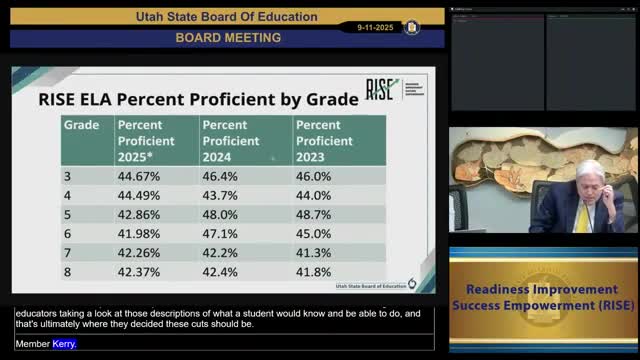Academic Panel Discusses Third Grade Proficiency Scores Using Acadience and RISE Assessments
September 15, 2025 | Financial Operations , Utah Board of Education, Offices, Departments, and Divisions, Organizations, Utah Executive Branch, Utah
This article was created by AI summarizing key points discussed. AI makes mistakes, so for full details and context, please refer to the video of the full meeting. Please report any errors so we can fix them. Report an error »

In a recent meeting held by the Utah State Board of Education (USBE) on September 15, 2025, discussions centered around the effectiveness of the Readiness Improvement Success Empowerment (RISE) assessment and its implications for student proficiency in reading. The meeting highlighted the complexities of comparing RISE scores with those from the Acadience assessment, particularly for third-grade students.
A key point of discussion was the potential for raising the proficiency benchmark based on Acadience results. Currently, RISE is used for assessing students in grades three and above, while Acadience is primarily focused on kindergarten through third grade. Board members explored how using Acadience as a benchmark could potentially show a higher percentage of students meeting proficiency standards. For instance, data revealed that 48.7% of third graders met the Acadience cut score for reading on grade level, indicating they are likely to succeed in future reading assessments.
The conversation also touched on the challenges of communicating these results to the public. Board members acknowledged that while RISE scores may appear lower—44.67% of students meeting proficiency—this is due to the higher standards set by the assessment. The board emphasized the importance of clearly explaining these benchmarks to stakeholders, especially in light of Utah's strong performance on the National Assessment of Educational Progress (NAEP).
Additionally, it was noted that 70.5% of third graders were at or above the benchmark in the most recent assessment, which further complicates the narrative around student performance. The board recognized the need for a consistent and clear message regarding the high standards set by RISE and how they relate to other assessments.
As the meeting concluded, members expressed a commitment to refining their communication strategies to better inform the public about the implications of these assessments and the rationale behind the benchmarks. The discussions underscored the ongoing efforts to enhance educational outcomes and ensure that all students are adequately prepared for future academic challenges.
A key point of discussion was the potential for raising the proficiency benchmark based on Acadience results. Currently, RISE is used for assessing students in grades three and above, while Acadience is primarily focused on kindergarten through third grade. Board members explored how using Acadience as a benchmark could potentially show a higher percentage of students meeting proficiency standards. For instance, data revealed that 48.7% of third graders met the Acadience cut score for reading on grade level, indicating they are likely to succeed in future reading assessments.
The conversation also touched on the challenges of communicating these results to the public. Board members acknowledged that while RISE scores may appear lower—44.67% of students meeting proficiency—this is due to the higher standards set by the assessment. The board emphasized the importance of clearly explaining these benchmarks to stakeholders, especially in light of Utah's strong performance on the National Assessment of Educational Progress (NAEP).
Additionally, it was noted that 70.5% of third graders were at or above the benchmark in the most recent assessment, which further complicates the narrative around student performance. The board recognized the need for a consistent and clear message regarding the high standards set by RISE and how they relate to other assessments.
As the meeting concluded, members expressed a commitment to refining their communication strategies to better inform the public about the implications of these assessments and the rationale behind the benchmarks. The discussions underscored the ongoing efforts to enhance educational outcomes and ensure that all students are adequately prepared for future academic challenges.
View full meeting
This article is based on a recent meeting—watch the full video and explore the complete transcript for deeper insights into the discussion.
View full meeting

